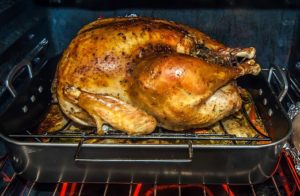For many families, Thanksgiving is simply the FIRST of many holiday meals that will be prepared. For so many households, Christmas Eve and New Year’s Eve meals are just as substantial as Christmas and New Year’s Day, or other December holidays such as Hanukkah and Kwanzaa.
But since Thanksgiving is the lead-off batter, and so many families serve turkeys in December as well, it’s a good idea to start with common, but often forgotten precautions that must be taken with turkey. The Environmental Health Division of the Will County Health Department advises you to read the label carefully on any turkey you purchase. And if you plan on serving it fresh, completely avoiding the “freezing and thawing” concerns, please purchase your turkey no more than two days before Thanksgiving.
For those, however, whose tradition is to have a frozen turkey tucked away in the freezer, having a plan for thawing is of utmost importance. The three safest ways to thaw your turkey are in the microwave as part of the cooking process (following instructions on the label concerning your turkey’s weight), running cold water over the turkey while it rests in the sink, or giving it proper time to naturally defrost in the refrigerator. (If you choose the refrigerator route, have an accurate thermometer in it so you can defrost the turkey at 41 degrees or less.) Two very common mistakes are waiting until the last minute to thaw a turkey, and then trying to do it at room temperature by simply having it rest on the counter.
You should also remember to never wash the turkey, as this will cause bacteria to spread onto kitchen surfaces and utensils. Fully cooking the turkey will kill any bacteria on or within the turkey. The turkey should be cooked to 165 degrees, and you should use an accurate probe thermometer to take its temperature in three places: the thickest part of the breast, the innermost part of the thigh, and the innermost part of the wing.
It is also very important to use separate cutting boards, knives, utensils, and plates when handling raw turkey; in order to prevent cross-contamination. And when you change from one task to the other (such as from preparing the turkey to preparing the stuffing) always use clean and sanitized utensils and dishware.
And as the leftovers are often a family’s favorite thing, sometimes even a big part of their whole tradition, extreme care is needed there as well. Leftovers should be refrigerated within two hours of the meal to prevent bacterial growth, and then stored in shallow pans to decrease cooling time. It is also important to not store leftover stuffing inside the turkey, and to avoid eating the leftovers more than four days after the meal. And if you have traveled and are taking leftovers home, they should be stored in a cooler with ice or gel packs.

It is important to check your turkey’s temperature (should be cooked to 165 degrees) in three places: the breast, the thigh, and the wing.
For ALL holiday meals, as well as year ‘round, it is of utmost importance to practice proper handwashing procedures. WCHD Environmental Health Director Tom Casey says this can be quite a challenge during family holiday meals. “You have people coming into the kitchen taste-testing food, kids wanting to help, and all of that activity.
“Perhaps you were working with raw meat, but now you will be working with ready-to-eat salad ingredients,” Casey explained. “Or maybe a dog and cat passed through the room and you petted them. When ANYTHING happens like that, it’s a ‘change in task,’ and your hands must be washed again.”
Casey also reminds us that having the correct hand washing supplies available is also important. “You want to avoid having a ‘common towel’ in both the kitchen and bathroom. In the kitchen, everyone should use paper towels to dry their hands. In the bathroom, it’s good to have a small stack of individuals towels available.”
And of course, make sure plenty of hand soap is on hand, and remember that 20 seconds of scrubbing with warm water and soap is your best bet. It is also a good idea to use the individual towel you dried your hands with to turn off the faucet.
For more on safe holiday food preparation, go to https://www.cdc.gov/features/turkeytime/index.html. For more on proper hand washing, go to https://www.cdc.gov/handwashing/index.html.

